J.E. Johnson, Jr.
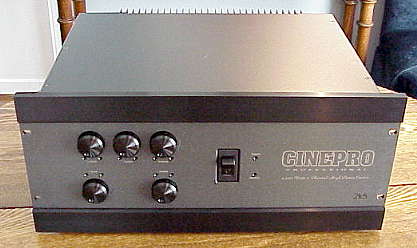 |
Cinepro 2k5 Five-Channel Power Amplifier 225 Watts RMS/Channel into 8 Ohms; 350 Watts/RMS/Channel into 4 Ohms; 450 Watts Center Channel, 8 Ohm Load with HPC Mfr. FR: 2 Hz - 150 kHz + 0, - 3 dB THD: < 0.015% Dynamic Headroom: 3.4 dB Damping Factor: 1,000 Size: 8"H x 19"W x 15 1/2"D Weight: 46 Pounds MSRP: $2,695 USA |
| Cinepro, Inc., 1030 Vicente, San Francisco, California 94116; Phone 1-800-395-1222; E-Mail [email protected]; Web http://www.Cinepro.com. |
I remember reviewing Cinepro's first product, a two channel power amplifier, several years ago. It sounded very nice, but it didn't have a big power supply because Eric Abraham (Cinepro designer/owner) wanted to keep the price down. Many companies tend to use smaller power supplies to attain a modest price-point. As consumers, we have become feature-hungry and low-price demanding. However, Eric realized the value in providing high power amplifiers that can deliver high power for more than just a millisecond. That takes a BIG power supply, and that is what he puts into his Cinepro amplfiers now.
The 2k5 is a five-channel power amplifier designed for home theater use. Eric put in the features plus the power and let the price fall where it may. That came out to be $2,695 which is no small amount of change. But, he has found that there is a market for massive raw power. Judging by the Mercedes he is driving now, I would say that the market has found him too.
The front of the 2k5 has a rocker on/off switch and five rotary volume controls for the five channels. Each volume control has two small LEDs associated with it. One is green to indicate that a signal is passing through the amplifier channel and one is red to indicate when the amplifier is reaching clipping levels (hard to do with this much power capability). The on/off switch also has LEDs to indicate power status.
The 2k5 actually has six channels.
Each circuit board has two amplifier channels on it, and it would
have actually been more expensive to design a one channel circuit
board for the fifth channel than to simply use another two channel
board and bridge them into one very high power channel. 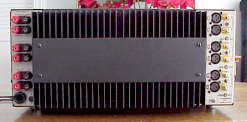 So, that is what he did, and this
bridged amplifier becomes the center channel because the center
is where most of the power is demanded. As a result, you get
225 watts @ 8 Ohms into four of the channels, and 450 watts @
8 Ohms for the center. You have the choice of using a single
amplifier channel for the center if you want, by switching a
toggle on the back, but as long as your center speaker has a
nominal impedance of at least 4 Ohms, you might as well have
the additional power (bridging reduces the ability to drive low
impedance speakers, and with the 2k5, non-bridged amplifier channels
will work with 2 Ohm loads).
So, that is what he did, and this
bridged amplifier becomes the center channel because the center
is where most of the power is demanded. As a result, you get
225 watts @ 8 Ohms into four of the channels, and 450 watts @
8 Ohms for the center. You have the choice of using a single
amplifier channel for the center if you want, by switching a
toggle on the back, but as long as your center speaker has a
nominal impedance of at least 4 Ohms, you might as well have
the additional power (bridging reduces the ability to drive low
impedance speakers, and with the 2k5, non-bridged amplifier channels
will work with 2 Ohm loads).
The rear panel is nicely laid out (see
photo at upper left), with all the input jacks on the right,
and all the speaker binding posts on the left. 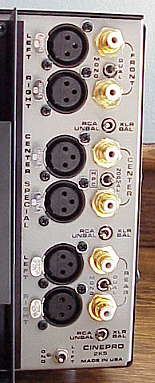 The
heat sinks are in the center. Each channel has balanced XLR as
well as unbalanced RCA (gold plated) jacks. There is a balanced/unbalanced
toggle for each channel and a toggle for bridging each pair of
channels. For the top and bottom two channels, non-bridged is
called "dual" and bridged is called "mono".
The
heat sinks are in the center. Each channel has balanced XLR as
well as unbalanced RCA (gold plated) jacks. There is a balanced/unbalanced
toggle for each channel and a toggle for bridging each pair of
channels. For the top and bottom two channels, non-bridged is
called "dual" and bridged is called "mono".
 For the center, non-bridged is
called "normal" and bridged is called "HPC"
for "High Power Center". The closeup photo on the lower
left shows the top two channels with the toggles. It would probably
be a good idea to write down the toggle configuration so you
can reach over the top of the amplifier and make any changes
you want by feeling your way down the column of toggles.
For the center, non-bridged is
called "normal" and bridged is called "HPC"
for "High Power Center". The closeup photo on the lower
left shows the top two channels with the toggles. It would probably
be a good idea to write down the toggle configuration so you
can reach over the top of the amplifier and make any changes
you want by feeling your way down the column of toggles.
At the bottom of the panel is one additional toggle for lifting the ground connection (photo at right). As you all know, connecting numerous home theater components together, usually with lots and lots of interconnects, often results in ground loop hum. The ground lift toggle can be very helpful with this problem. However, if you don't have ground loop hum, leave the toggle in the grounded position, as this is a safety measure.
The inside of the 2k5 is stuffed with goodies.
In the photo shown at the lower left, the front of the amplifier
is at the top. On the inside, a large toroidal transformer (2.1
kVA, 2,100 watts) is on the left, and the power supply circuit
board is on the right. Two large power supply capacitors (100
Volt, 35,000 µF each) are under the power supply circuit
board. Click ![]() the video button to see (download
to your media player) a short video, with audio, describing the
circuit boards with closeups. At the rear of the chassis are
three amplifier circuit boards, each with twelve bipolar output
transistors (six per channel). Each amplifier channel uses four
gain stages (input, pre-driver, driver, output). The DC voltage
on the power supply capacitors is ±82 V, giving 235 Joules
of energy storage. The two power supply capacitors each actually
contain three smaller ones, which provides for lower series inductance.
Putting the three in one jacket allows having a total of six
smaller capacitors that will fit in the chassis. There is a fan
in the 2k5 that turns on when and if it gets too warm. I could
not get it to activate, but I understand that some people object
to fan noise in power amplifiers. Personally, I have had fans
in several power amps, and they have never bothered me. If I
am listening so loud that the fan needs to come on, the soft
whoosh it makes is the last thing on my mind.
the video button to see (download
to your media player) a short video, with audio, describing the
circuit boards with closeups. At the rear of the chassis are
three amplifier circuit boards, each with twelve bipolar output
transistors (six per channel). Each amplifier channel uses four
gain stages (input, pre-driver, driver, output). The DC voltage
on the power supply capacitors is ±82 V, giving 235 Joules
of energy storage. The two power supply capacitors each actually
contain three smaller ones, which provides for lower series inductance.
Putting the three in one jacket allows having a total of six
smaller capacitors that will fit in the chassis. There is a fan
in the 2k5 that turns on when and if it gets too warm. I could
not get it to activate, but I understand that some people object
to fan noise in power amplifiers. Personally, I have had fans
in several power amps, and they have never bothered me. If I
am listening so loud that the fan needs to come on, the soft
whoosh it makes is the last thing on my mind.
I tested the 2k5 with a reference music
system consisting of our Audio Alchemy CD Transport, Jitter Reduction,
and DAC, the Audio Electronic AE-1 Triode Tube Preamplifier,
and Monitor Audio Studio 20SE Speakers. The home theater reference
system consists of a Yamaha DVD-S700 DVD Player, Yamaha DSP-A1
Processor (using the pre-out jacks), and Krix Speakers. All cabling
is Nordost.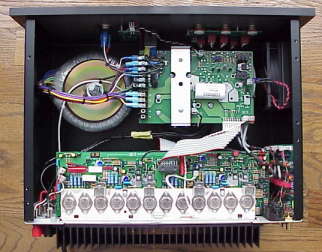
I was quite impressed with the articulate way the 2k5 handled two-channel stereo. Crisp, clear high end, palpable midrange, and deep bass. There is nothing like raw clean power. Low noise characteristics allowed all the fine detail to come through as well.
One of the advantages of having that sixth channel available is that you can use the 2k5 to tri-amplify speakers. Our Krix mains have the three sets of binding posts for tri-amping, and utilizing 675 watts to drive each of these tower speakers is really an experience. You don't have to turn it up loud to get the benefit. At modest levels, there is so much reserve that the amplifier just coasts along, and it provides impulse power during the high demand transients. It would be nice to have a small volume control for that sixth channel on the back, but there are so few tri-ampable speakers out there that it would have been an additional expense not used by most consumers. I got around this by connecting the sixth channel to the woofer and leaving the woofer volume control for the other speaker at full on, while adjusting the volume controls for the tweeter and midrange on the other four amplifier channels to suit my tastes (I like a little less tweeter and midrange and more deep bass).
For the home theater tests, I used quite an arsenal. Chapters 4 and 11 of the "True Lies" Dolby Digital laserdisc have plenty of sharp transients and thunderous bass that are very taxing to any amplifier. When Schwarzenegger says, "Here is my invitation," get ready to rumble. A huge explosion is followed by machine gunfire popping in all the channels. I cranked this scene up as loud as I could stand it, and nary a red LED illuminated on the 2k5 front panel. The sound always remained clear, and never harsh, all the way through. In chapter 11, where the terrorists are trying to kill Schwarzenegger in the bathroom, the gunshots and the spent shells bouncing on the floor, both were clear as the proverbial bell even though the shots were happening at the same time the spent shells were hitting the floor (complicating the waveform).
I have several digital surround music discs, including the DTS 5.1 CD recording of Holst's "The Planets" (Telarc CD-80466) and the Dolby Digital 5.1 DVD recording "DVD Music Breakthrough" (Delos DV-7002). I also have 24/96 DVD music recordings. Although 24/96 has more body to it than either DTS or DD (due to the compression inherent in DTS and DD right now), I have to say that I very much prefer 5.1 digital surround recordings over two-channel stereo. The depth of the soundstage in digital surround overshadows the higher quality of the larger bitrate in two-channel 24/96. We can all look forward to the day when high bitrate 5.1 recordings become available for music and movies. The Holst DTS CD has a thunderous opening with "Mars, the bringer of war", and the entire room shook when I turned up the volume on the 2k5. The combination of 225 watts per channel, plus the large number of speaker drivers that one has when using five speakers, allows for getting clean sound at higher volume, because the amount of air that each driver has to move is smaller than when using two-channel stereo at the same volume. Of course this requires good speakers, and clean amplifier power, regardless of the mode, and the Cinepro 2k5 delivers.
The amplifier has 3.4 dB of dynamic headroom, which means that it can deliver more than twice its rated power for a short transient peak, i.e., about 500 watts per channel into 8 Ohm loads. This more than meets THX standards even though the 2k5 is not THX-certified. The 225 watt/channel specification for the 2k5 means that it will deliver 225 watts per channel at any sinewave frequency with that sinewave being fed into all five channels simultaneously, and over a period of say three seconds of testing. Dynamic headroom is measured in a different way. A 0.1 second pulse at 100 Hz is fed into all the channels, and the amount of power output just before clipping is measured and specified as the number of dB over the continuous power rating. This is the dynamic headroom, and 3 dB represents twice the continuous power rating. Depending on the power supply and other factors, the dynamic headroom might be only 1 dB over the continous rating, or as in the case of the 2k5, it is more than 3 dB (more than twice the continuous power rating). This means that short transients will come through because they can demand a lot of power, and the 2k5 has it.
In practice, I found there was plenty of power for my center channell speaker, which is 8 Ohms and reasonably sensitive, just using the center unbridged. However, for the HPC setting, I turned the center channel volume control on the 2k5 all the way up, then set the other channel volume controls to mid-level. Then, I used the test tones on the receiver to adjust all of the channels so that they were matched in volume. After that, the volume controls on the 2k5 were extremely handy in fine tuning each channel (other than the center, which must remain at full level when using the HPC) for individual movies. I did not have any ground loop hum, even with all those interconnects, but the ground lift toggle would be useful if I had noticed any hum.
The squarewave response of the 2k5 at 10
kHz and ±10 Volts, shows a rounded leading edge, which
is due to the relatively narrow bandwidth of 60 kHz (down 3 dB
from sinewave measurement at 10 kHz). 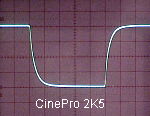 Cinepro
designed the 2k5 to work with any type of speaker, and figuring
that the user would want to play their system loud. Using output
inductors to restrict the bandwidth gives the 2k5 stability into
just about any type of speaker at high volume. The drawback of
narrow bandwidth is a risk of phase shift in the upper frequencies
of the audio band, but that is the price of having a high power
amplifier that works with any speakers, even electrostatics.
On the other hand, lower bandwidth is a consequence of not using
much negative feedback, and the 2k5 has just four gain stages,
which is good. You can increase the bandwidth by adding negative
feedback, but the gain is reduced. Adding more gain stages will
bring the gain up again, without changing the bandwidth. One
begins to see how complicated amplifier design is. I'm a fan
of simple circuitry without a lot of negative feedback, and the
2k5 meets those requirements.
Cinepro
designed the 2k5 to work with any type of speaker, and figuring
that the user would want to play their system loud. Using output
inductors to restrict the bandwidth gives the 2k5 stability into
just about any type of speaker at high volume. The drawback of
narrow bandwidth is a risk of phase shift in the upper frequencies
of the audio band, but that is the price of having a high power
amplifier that works with any speakers, even electrostatics.
On the other hand, lower bandwidth is a consequence of not using
much negative feedback, and the 2k5 has just four gain stages,
which is good. You can increase the bandwidth by adding negative
feedback, but the gain is reduced. Adding more gain stages will
bring the gain up again, without changing the bandwidth. One
begins to see how complicated amplifier design is. I'm a fan
of simple circuitry without a lot of negative feedback, and the
2k5 meets those requirements.
In summary, the Cinepro 2k5 is an excellent five-channel power amplifier, with all the features and build-quality one could ask for at an attractive price. It will handle any sound source one can throw at it, and it retains its poise. This product is a must hear when you are auditioning power amplifiers for your home theater (Cinepro has about 120 dealers in the USA and more on the way in Canada).
John E. Johnson, Jr.
© Copyright 1999 Secrets of Home Theater & High Fidelity
Return to Table of Contents for this Issue.

